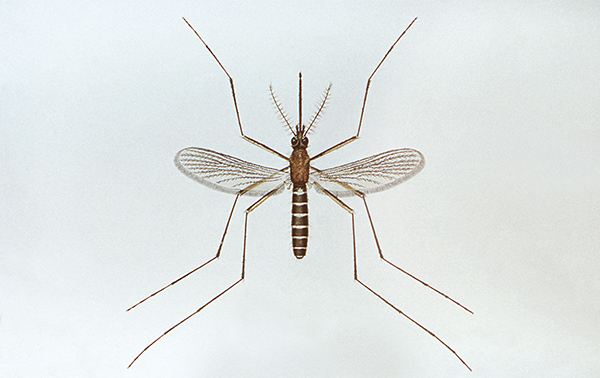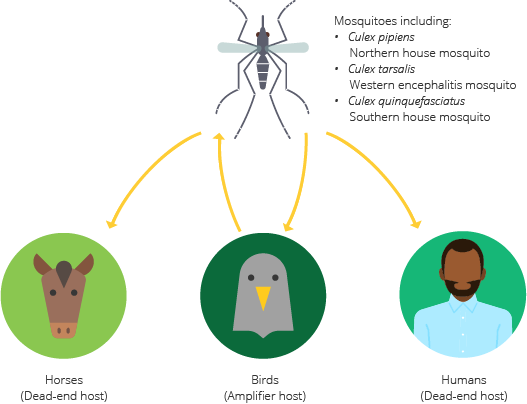WEST NILE VIRUS
What mosquitoes can carry and transmit West Nile virus?
While there are many mosquito species that may be able to transmit West Nile virus, the main mosquito species that transmit the virus in the United States are Culex pipiens, the northern house mosquito, Culextarsalis, the Western encephalitis mosquito, Culex quinquefasciatus, the southern house mosquito, and Culex nigripalpus, the Florida SLE mosquito.

Culex pipiens

Culex tarsalis

Culex quinquefasciatus
Where do they live?
These four potential West Nile virus mosquito vectors use permanent bodies of water, like ponds, as immature habitats, but can also use water-filled containers around the home as immature habitats as well. Unlike Zika, dengue, and chikungunya virus mosquito vectors, the species of mosquitoes that can transmit West Nile virus primarily bite after dusk and up until dawn.
What can I do to prevent infection?
KEEP EMPTY
Eliminating Immature Mosquito Habitats
Because these four mosquito species can use water-filled containers as immature habitats, it is important to practice source reduction around your home. The mosquito life cycle is defined by four major life stages: 1)egg, 2) larva, 3) pupa, and 4) adult.
The adult is the life stage people are likely the most familiar with. In the adult stage, mosquitoes fly around, and the females try to feed on blood.
However, people may be less familiar with the larvae and pupae, or the immature stages of the mosquito. The immature stages live in the water. Eliminating larval development sites is an excellent way to prevent the mosquitoes (including the mosquito species transmitting Zika, dengue, and chikungunya) from completing their life cycle.
To do this, simply go around your home and identify any containers that are holding water. Trash items can be discarded. For containers that will regularly refill with water, dumping out the water every five days will prevent immature mosquitoes from being able to reach to adulthood. As an extra step, scrub the interior surfaces of the container with a sponge to dislodge any remaining mosquito eggs and rinse them off. If you have tires on your property, check with your local mosquito control or waste program. There may be programs in place to dispose of the tires on your property! For decorative ponds that cannot be emptied out regularly, consider stocking it with mosquito fish (ex: Gambusia affinis, Gambusia holbrooki) or utilizing a biological control agent, such as products with the active ingredient Bti (Bacillus thuringiensis subspecies israelensis).
Using Repellents
In addition to regularly engaging in container elimination and/ or sanitation practices, using repellants when outdoors and wearing long sleeves and pants can prevent mosquitoes from feeding on you. When using repellents, make sure to choose from the list of CDC-recommended repellents.
Protecting Your Home
Preventing mosquitoes from entering the home is also important to preventing mosquito bites. This includes ensuring that all windows are covered with screens and that the doors to the home remain closed. Essentially, all entry points to the home should be sealed or covered by a screen. These screens should be checked regularly to ensure that there are no holes that would allow a mosquito to slip through. Damaged screens can be repaired or replaced to prevent mosquitoes from entering the home.
What are the symptoms of a West Nile virus infection?
Most people infected with West Nile virus do not exhibit symptoms. Approximately 20% of infected individuals will develop a fever and a headache, body aches, joint pain, vomiting, diarrhea, or rash. After recovering from the infection, individuals may still suffer from fatigue or weakness for weeks or months. Some studies suggest that there may be chronic problems associated with West Nile virus infection. Symptoms will usually begin three to 14 days after being bitten by an infected mosquito.
A small proportion of people – approximately 1 in 150 – will develop serious symptoms. This may include encephalitis (swelling of the brain) or meningitis. This may be accompanied by a high fever, headache, neck stiffness, stupor, disorientation, coma, tremors, convulsions, muscle weakness, vision loss, numbness, and paralysis. Approximately 1 out of 10 people who develop serious illness affecting the central nervous system as a result of West Nile virus infection will die. Older individuals are at higher risk of developing serious infection.
What does the West Nile virus transmission cycle look like?
West Nile virus is most commonly spread via mosquito bites. Mosquitoes become infected when they feed on an infected bird. Once the female mosquito finishes taking the bloodmeal, she cannot immediately transmit to another organism. The virus incubates and multiplies within the mosquito. During this time, she will lay her eggs and eventually look for another bloodmeal. It is during these future bloodmeals that she may be capable of transmitting West Nile virus to a new host. If she feeds on another bird, it continues the cycle of transmission between birds and mosquitoes. However, the infected mosquito may feed on a human or other animal, such as a horse. While the human and the horse can develop illness from West Nile virus infection, subsequent mosquitoes feeding on them will not be able to pick up the virus from their blood. Therefore, humans and horses are considered “dead-end hosts” for the virus, because they may develop symptoms but cannot infect a mosquito.



